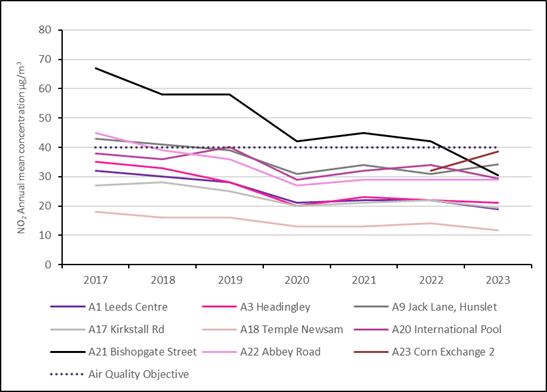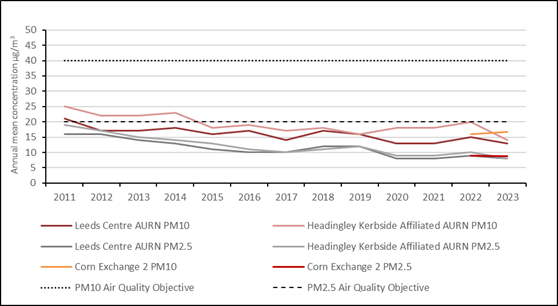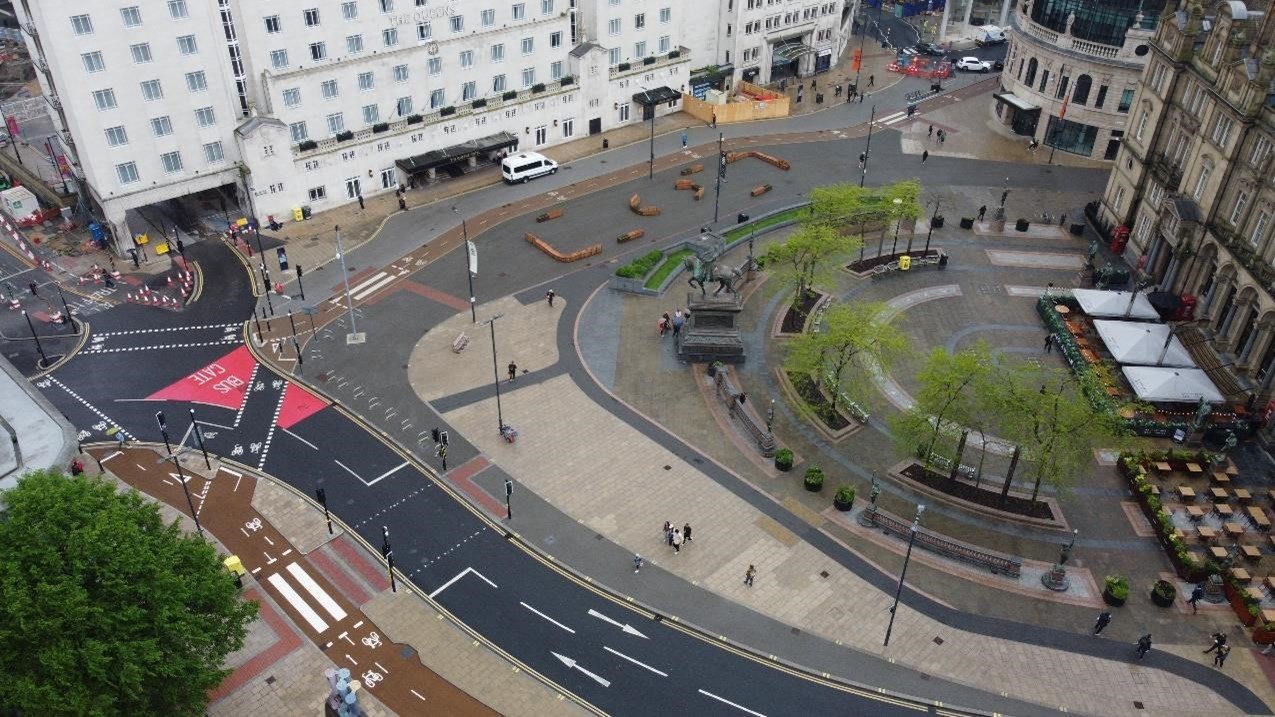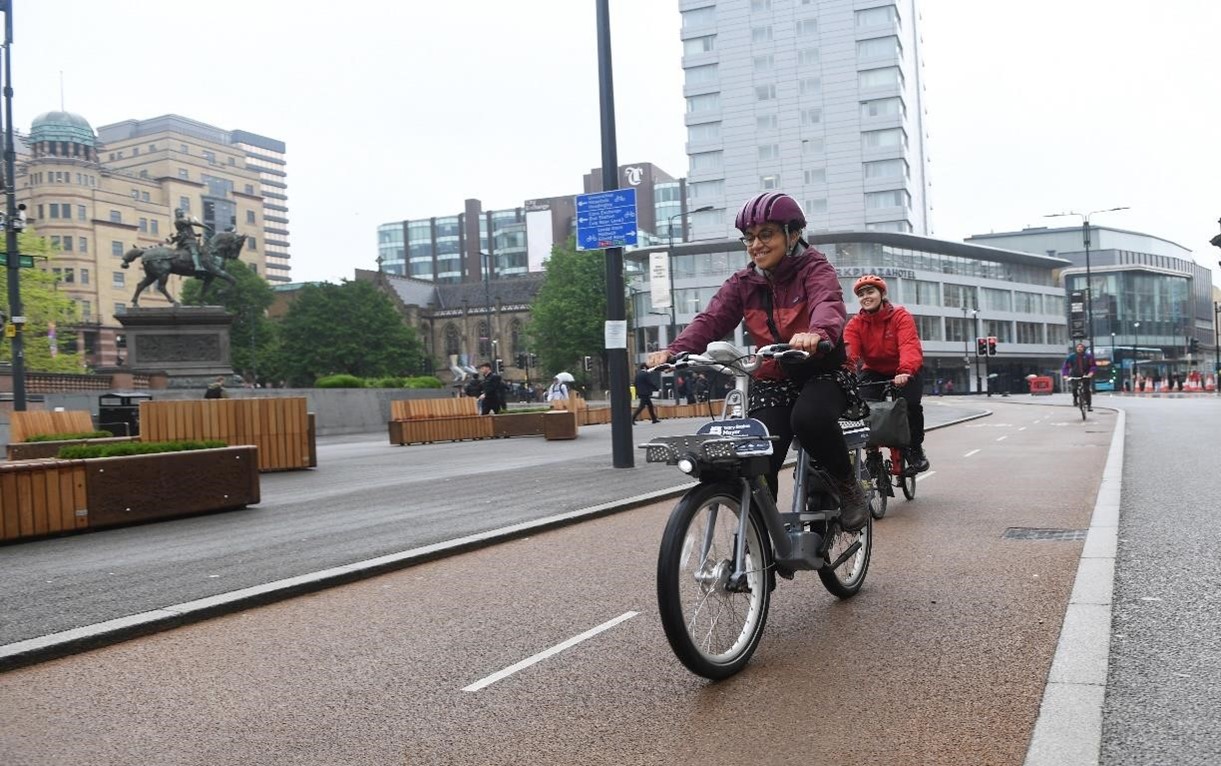Air quality in Leeds
Breathing in polluted air affects our health and costs the NHS and our society billions of pounds each year. Air pollution is recognised as a contributing factor in the onset of heart disease and cancer and can cause a range of health impacts, including effects on lung function, exacerbation of asthma, increases in hospital admissions and mortality. In the UK, it is estimated that the reduction in healthy life expectancy caused by air pollution is equivalent to 29,000 to 43,000 deaths a year (UK Health Security Agency. Chemical Hazards and Poisons Report, Issue 28, 2022).
Air pollution particularly affects the most vulnerable in society, children, the elderly, and those with existing heart and lung conditions. Additionally, people living in less affluent areas are most exposed to dangerous levels of air pollution (Defra. Air quality and social deprivation in the UK: an environmental inequalities analysis, 2006).
Table ES 1 provides a brief explanation of the key pollutants relevant to local air quality management and the kind of activities they might arise from.
Table ES 1 - Description of key pollutants
| Pollutant | Description |
|---|---|
| Nitrogen Dioxide (NO2) | Nitrogen dioxide is a gas which is generally emitted from high temperature combustion processes such as road transport or energy generation. |
| Sulphur Dioxide (SO2) | Sulphur dioxide (SO2) is a corrosive gas which is predominantly produced from the combustion of coal or crude oil. |
| Particulate Matter (PM10 and PM2.5) |
Particulate matter is everything in the air that is not a gas. Particles can come from natural sources such as pollen, as well as human made sources such as smoke from fires, emissions from industry and dust from tyres and brakes. PM10 refers to particles under 10 micrometres. Fine particulate matter or PM2.5 are particles under 2.5 micrometres. |
There are two primary pollutants of concern for Leeds, Nitrogen Dioxide (NO2) and Particulate matter (PM10 and PM2.5).
Outdoor air pollution in most of the city, its suburbs and surrounding rural areas meets the UK’s air quality objectives in 2023. However, there are two locations in the City Centre that remain above the annual mean air quality objective for Nitrogen Dioxide.
Trend in NO2 annual mean concentrations at Leeds air quality monitoring stations

| 2017 | 2018 | 2019 | 2020 | 2021 | 2022 | 2023 | |
|---|---|---|---|---|---|---|---|
| UK Objective NO2 (µg/m3) | 40 | 40 | 40 | 40 | 40 | 40 | 40 |
| A1 Leeds Centre (AURN) | 32 | 30 | 28 | 21 | 22 | 22 | 19 |
| A2 Corn Exchange | 54 | 51 | 49 | 38 | 38 | ND | ND |
| A3 Headingley (AURN) | 35 | 33 | 28 | 20 | 23 | 22 | 21 |
| A6 Haslewood Close | 42 | 40 | ND | ND | ND | ND | ND |
| A9 Jack Lane, Hunslet | 43 | 41 | 39 | 31 | 32 | 31 | 34 |
| A17 Kirkstall Road | 27 | 28 | 25 | 20 | 21 | 22 | 19 |
| A18 Temple Newsam | 18 | 16 | 16 | 13 | 13 | 14 | 12 |
| A19 Tilbury Terrace | 34 | 31 | 33 | 23 | ND | ND | ND |
| A20 International Pool | 38 | 36 | 40 | 29 | 32 | 34 | 30 |
| A21 Bishopgate Street | 67 | 58 | 58 | 42 | 45 | 42 | 30 |
| A22 Abbey Road | 45 | 39 | 36 | 27 | 27 | 29 | 29 |
| A23 Corn Exchange 2 | ND | ND | ND | ND | ND | 32 | 39 |
In 2023, the annual mean air quality objective for NO2 was met at all our monitoring stations, continuing the general trend of long-term improvement in air quality in Leeds.
Two monitoring stations did record increased annual average concentrations of NO2 in 2023. A new monitoring station was introduced in 2022 in the city centre at the roadside near to the New Market Street and Call Lane junction. The annual mean concentration of NO2 recorded in 2023 increased to 39 µg/m3from 32 µg/m3in 2022. The monitor located on Jack Lane, Hunslet recorded an increase from 31 µg/m3 in 2022 to 34 µg/m3 in 2023.
The UK Air Quality Objective also limits the number of hours where NO2 concentrations should exceed 200µg/m3. No single location should exceed this limit more than 18 hours in a single year. In 2023 every location monitored in Leeds met this NO2 hourly limit as there were no recorded hourly exceedances of NO2 concentrations above 200µg/m3.
In 2023 national statistics for annual mean concentrations of NO2 showed an average decrease of 9% at urban background sites and 8% at roadside/kerbside sites from 2022 levels. In Leeds, our urban background site (city centre) recorded a 14% decrease, whilst our roadside/kerbside sites showed a 5% decrease from 2022 results.
NO2 annual average concentrations recorded in Leeds in 2023 remain below 2019 (pre-pandemic) concentrations.
Particulate matter is monitored at Leeds Centre AURN, Headingley Kerbside AURN and the Corn Exchange Kerbside sites. PM10 and PM2.5 were well within UK Air Quality Objectives in 2023.
Trend in particulate matter annual mean concentrations at Leeds air quality monitoring stations

| 2013 | 2014 | 2015 | 2016 | 2017 | 2018 | 2019 | 2020 | 2021 | 2022 | 2023 | |
|---|---|---|---|---|---|---|---|---|---|---|---|
| UK Air Quality Objective PM10 (µg/m3) | 40 | 40 | 40 | 40 | 40 | 40 | 40 | 40 | 40 | 40 | 40 |
| Leeds Centre AURN (PM10) | 17 | 18 | 16 | 17 | 14 | 17 | 16 | 13 | 13 | 15 | 13 |
| Headingley Kerbside AURN (PM10) | 22 | 23 | 18 | 19 | 17 | 18 | 16 | 18 | 18 | 20 | 14 |
| A23 Corn Exchange 2 Kerbside (PM10) | ND | ND | ND | ND | ND | ND | ND | ND | ND | 16 | 17 |
| UK Air Quality Objective PM2.5 (µg/m3) | 20 | 20 | 20 | 20 | 20 | 20 | 20 | 20 | 20 | 20 | 20 |
| Leeds Centre AURN (PM2.5) | 14 | 13 | 11 | 11 | 10 | 12 | 12 | 8 | 8 | 9 | 8 |
| Headingley Kerbside AURN (PM2.5) | 15 | 14 | 13 | 11 | 10 | 11 | 12 | 9 | 9 | 10 | 8 |
| A23 Corn Exchange 2 Kerbside (PM2.5) | ND | ND | ND | ND | ND | ND | ND | ND | ND | 9 | 9 |
ND = No data
In 2023 national statistics for annual mean concentrations of both PM10 and PM2.5 at urban background sites decreased by an average 12% from 2022 concentrations. The Leeds urban background site (city centre) showed comparable results to the national picture with a decrease of 13% for PM10 and 11% for PM2.5.
The national average decrease for roadside/kerbside PM10 and PM2.5 was 10% and 12% respectively. Leeds kerbside sites showed decreases of 15% for PM10 and 11% for PM2.5.
Leeds has previously declared six Air Quality Management Areas (AQMA’s) within the district due to exceedances of NO2 objectives. Comprehensive monitoring has identified that air quality within five of the AQMA’s is now compliant with UK Objectives and has been so for a number of years. The formal process to revoke AQMA status from these areas in underway and is scheduled to be completed in 2024. The AQMA’s to be revoked in 2024 are:
- Ebor Gardens, Burmantofts
- Caspar Apartments, North Street
- The Normans, Kirkstall
- The Tilburys, Holbeck
- Chapel Hill, Morley
In 2023, the AQMA located on Main Street, Pool in Wharfedale, met UK air quality objectives for the first time since the area was declared in 2017. Monitoring will continue at the site to assess for long term compliance with air quality objectives.
Further information on our AQMA’s can be found at: List of Local Authorities with AQMAs-Defra, UK.
The Leeds Air Quality Strategy sets out how the council intends to continue to ensure the ongoing improvement in air quality. The plan includes actions to tackle air pollution from transport, home, industry and agriculture. We will also work with the health and care sector to ensure that the most vulnerable residents understand how best to protect themselves from pollutants.
Actions to improve air quality
Whilst air quality has improved significantly in recent decades, there are some areas where local action is needed to protect people and the environment from the effects of air pollution.
The Environmental Improvement Plan (Defra. Environmental Improvement Plan 2023, January 2023) sets out actions that will drive continued improvements to air quality and to meet the new national interim and long-term targets for fine particulate matter (PM2.5), the pollutant of most harmful to human health. The Air Quality Strategy (Defra. Air Quality Strategy – Framework for Local Authority Delivery, August 2023) provides more information on local authorities' responsibilities to work towards these new targets and reduce fine particulate matter in their areas.
The Road to Zero (DfT. The Road to Zero: Next steps towards cleaner road transport and delivering our Industrial Strategy, July 2018) details the Government’s approach to reduce exhaust emissions from road transport through a number of mechanisms, in balance with the needs of the local community. This is extremely important given that cars are the most popular mode of personal travel and the majority of Air Quality Management Areas (AQMAs) are designated due to elevated concentrations heavily influenced by transport emissions.
Leeds City Council is committed to reducing emissions to protect the health of everyone in the city. Doing so supports the strategic pillars (inclusive growth, zero carbon, health and wellbeing) of our Best City Ambition.
The council recognises that there are no truly ‘safe’ levels of air pollution: any exposure to polluted air can have a detrimental impact on our health.
The Leeds Air Quality Strategy sets out actions that the council is taking to reduce exposure to, and underlying levels of, air pollution. The strategy also set new targets for local air quality that seek more rapid improvements than required by UK law.
More information about the steps we are taking to protect residents from air pollution. A summary detailing a few recent examples of completed or ongoing work is included below.
Improving charging infrastructure for cleaner plug-in vehicles
Work to develop the electric vehicle charge infrastructure across the city is continuing at pace. Plug-in vehicles are significantly cleaner and greener than petrol or diesel models. Official data shows that there are now more than 50,000 registered in Leeds. By facilitating the installation of plug-in vehicle charge points at more locations, Leeds City Council is making it easier and attractive for drivers to use these cleaner vehicles. We have worked with several partners to secure funding and install vehicle charge points at a number of off-street locations. According to official data, there are now 514 public charge points available in Leeds. All charge points installed in partnership with the council are supplied with renewable energy as part of our Net Zero strategy.
Since 2019, local planning policies have required developers to install vehicle charge points in all new developments, both residential and non-residential, with parking.
A project to develop on street charging design guidance is now in place and will be tested with the introduction of an on street charging pilot in 2024.
The council is also supporting work by the West Yorkshire Combined Authority to develop a regional strategy for the development of plug-in vehicle infrastructure. More information about work to improve plug-in vehicle charging in Leeds can be found on our website.
Our own fleet improvement is ongoing with further electric vehicles being sought to add to the existing zero emission fleet of almost 400 vehicles. The first fully electric refuse collection vehicles are due to be received in early 2024, with work to identify opportunities in other vehicle categories for EV transition in progress.
Domestic energy
The Leeds PIPES district heating network continues to be a strategic priority for the council, with Phase 3 underway in 2023. The Recycling and Energy Recovery Facility (RERF) now provides low carbon heat to around 1900 council tenants in multi-storey flats, and 26 non-domestic buildings including commercial customers and the council’s own buildings in the Civic Quarter of the city. The PIPES network offers a cheaper, reliable, low carbon, less polluting alternative for heating compared to conventional gas.
Monitoring technology
The Council continues to work with academics across the city, including Leeds Becketts University and the University of Leeds. The Purple Air Project is enhancing coverage of air quality monitoring and providing richer data that better informs our understanding of pollutant concentrations, localised peaks in pollution and potential sources. The Purple Air Project includes the installation of 40 sensors at locations such as schools, which will assist with understanding of impacts on vulnerable groups.
The Council working with regional partners and the West Yorkshire Combined Authority secured a £220,000 Defra Air Quality Grant in 2023 that will deliver the West Yorkshire Public Particulate Information Improvement Project (PIIP). The project includes the introduction of a network of particulate monitors across West Yorkshire and the development of a data dashboard that will support public health messaging, communication campaigns and help target actions to reduce emissions in key locations.
Encouraging active travel and modal shift
Leeds City Council has recently installed a programme of transport improvements including bus priority lanes, cycle lanes, modernised transport facilities and improved public spaces. The work supports the Connecting Leeds transport strategy vision of transforming travel in Leeds to make it easy and convenient to get around without a car. The upgrades support modal shift towards cycling and public transport and will help reduce emissions from private transport.
The closure of City Square to general traffic marks an important move towards transforming the city centre, improving the main gateway to the city from the railway station, prioritising public transport and creating public spaces for the people of Leeds to enjoy. Monitoring of city centre travel habits between 2022 and 2023 has shown a 10 per cent reduction in the use of private cars, with bus, rail, walking and cycling all increasing.
City Square transformation scheme

The successful launch of the Leeds City e-bikes scheme in 2023, which is the largest of its kind in the UK, will help more people make the switch to cycling for some of their journeys.
In the first month of operation 2,649 journeys were made covering 7,938km.
Leeds City Bikes - fully electric public hire service

In 2023 the School Streets initiative continues to grow, with the addition of a further three schools. The scheme restricts motorised traffic during school pick-up and drop-off times to make the space outside schools more pleasant, cleaner and safer for people walking, cycling and wheeling to school.
Leeds City Council has worked in partnership with the West Yorkshire Combined Authority and First Leeds to introduce major new park and ride sites at Elland Road, Temple Green, and Stourton. The Stourton facility is served by electric double decker buses and is the UK’s first fully solar powered park and ride site. Collectively, the three sites can help reduce city centre traffic by up to 3,949 vehicles at any one time.
Conclusions and priorities
Air quality in Leeds has improved significantly in recent years. Concentrations of Nitrogen Dioxide (NO2) in particular have reduced considerably since 2019. So much so that five of our six Air Quality Management Areas are to be revoked in 2024. The remaining AQMA located on Main Street, Pool in Wharfedale, met UK air quality objectives for the first time in 2023 since the area was declared in 2017.
Air quality in most of the city, it’s suburbs and surrounding rural areas meet the UK’s Air Quality Objectives in 2023. The automatic NO2 monitoring results for 2023 show that none of the automatic monitoring sites exceeded the NO2 annual mean air quality objective of 40ugm-3 or recorded any exceedances of the 1-hour mean objective of 200µgm-3.
Whilst most of the automatic monitoring stations recorded decreasing concentrations of NO2 in 2023 compared to 2022, two monitoring stations did record increased annual average concentrations of NO2 compared to the previous year. The New Market Street monitor recorded an annual mean concentration of NO2 of 39 µg/m3, up from 32 µg/m3in 2022. The monitor for Jack Lane, Hunslet recorded an annual mean increase for NO2 from 31 µg/m3 in 2022 to 34 µg/m3 in 2023. Investigation and further monitoring is ongoing to identify any contributing factors for the increases in NO2 at these locations.
Diffusion tube monitoring results from 201 sites during 2023 show that the NO2 annual mean air quality objective of 40ug/m3 was exceeded at only 2 sites. This is an improvement on 2022 when 12 diffusion tube sites exceeded the NO2 annual mean air quality objective. The two exceeding sites in 2023 were in the city centre, located on Neville Street (kerbside) measuring 47.7µg/m3 and Wellington Street (roadside) measuring 40.7µg/m3. Neville Street is located within the Leeds Station Sustainable Travel Gateway scheme. The scheme is currently underway, scheduled for completion in 2025 and will significantly reduce the volume of traffic and associated pollution on Neville Street. The Wellington Street location is at the roadside where exposure times to the public would be limited to passers-by rather than in close proximity to residential or sensitive buildings. Due to the limited time the public would be reasonably expected to spend in both these areas the most relevant Air Quality Objective is the 1-hour mean Objective of 200 µg/m3 of NO2. Exceedances of the NO2 1-hour mean are unlikely to occur where the annual mean diffusion tube result is below 60µg/m3.
Priorities for the coming year
Air quality action plan
The current plan is to be reviewed and updated in 2024.
Transport
work to reduce emissions through transition to lower or zero-tailpipe emission vehicles and shifts in travel behaviours towards active travel and public transport use. This includes working on our own fleet, supporting the transition of private vehicles through development of electric vehicle charging infrastructure, working to deliver the infrastructure required for cycling and walking and supporting modal shift in line with the Connecting Leeds Strategy.
Public health
The current position of Public Health on Air Quality is that it remains the largest environmental health risk in the UK and that there are no safe levels of the main pollutants of concern (NO2 and PM). In line with the Chief Medical Officer’s recommendations, it is recognised that there is a clear role for public health action to reduce exposure and contributions to indoor and outdoor pollution. The Leeds Air Pollution and Health Group (LAPHG) is a citywide multi-agency partnership involving partners from Health Protection, Environmental Health, NHS, Housing, Highways and Transportation, University of Leeds, Climate Energy and Green Spaces. LAPHG will continue to work with the wider health care profession to raise awareness of the critical links between air pollution, exposure, and ill-health and to address the health inequalities exacerbated by air pollution in Leeds.
Air quality monitoring
Continue to expand and develop air quality monitoring across the city through collaborative working with the Combined Authority and academics to build an ever more in-depth picture of air pollution sources, trends and impacts. This will also include providing greater access to air quality data to the public and to better understand where work on air pollution and reducing exposure can be targeted.
Domestic energy, insulation and cooking
Work to decarbonise homes and workplaces, improving insulation, and improving the sources of heating will continue in 2024. We will continue to expand the Leeds PIPES network into new areas of the city based on likely customer demand.
Communication and engagement
Through working with key stakeholders, from Public Health, organisations such as Asthma+Lung UK, academics, and local and community groups across the city we can build better messaging and advice on both reducing emissions and reducing exposure to air pollution. Work targeting health care professionals, schools and other groups means we can raise awareness of how air quality can be improved. Further awareness campaigns are scheduled to provide information on the impact of wood burning, the impact of gas cooking and the benefits of switching to low carbon, low emissions sources of heating.
Environmental health and planning
Ongoing assessment of industry, evaluation of new developments and collaborative and consultative work on the Leeds Local Plan Update means that air quality remains a critical consideration in Leeds and part of any decision-making process when building a sustainable city.
Local engagement and how to get involved
Leeds City Council has published extensive information and advice online at the Clean Air Leeds website. The website has been designed and written to be as accessible as possible to facilitate public understanding and transparency. It fully complies with the public sector accessibility regulations. Content includes:
- air pollution and air quality in Leeds
- what we are doing about air pollution
- how to reduce your emissions
- protect yourself from air pollution
- report air quality and pollution issues
- watch a video about air pollution in Leeds
The council regularly engages with residents about air quality and related issues on social media through the dedicated Climate Emergency and Air Quality account on Twitter(@LeedsCC_CEAQ) and other social media channels. A monthly email newsletter with the latest updates and opportunities relating to climate action and air quality is also published and currently has more than 7,000 subscribers.
Additionally, the council marks awareness days including national Clean Air Day with a range of events, announcements, and campaigns to raise awareness of important key messages. Activities for Clean Air Day 2023 included supporting primary schools with lesson plans and resources to support clean air day learning sessions and publicising the Air Quality Alert scheme on the big screen in Millennium Square from 12 to 18 September. The opportunity was also used to encourage local businesses to take up the council’s try before you buy e-cargo bike scheme.
The council regularly engages with businesses one-to-one and encourages organisations to sign up to the West Yorkshire Travel Plan Network to create cost-effective, sustainable ways to travel for business and to commute to work.
The council’s Influencing Travel Behaviour service regularly engages with schools and school pupils to encourage safe and sustainable travel.
Finally, council officers and councillors meet with the Leeds Clean Air Alliance local action group by attending meetings several times a year and ensuring the group can feedback on policy proposals.